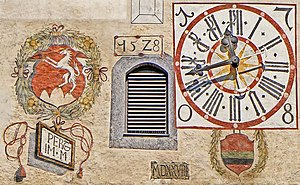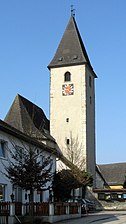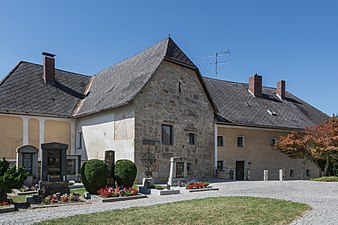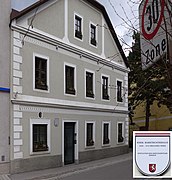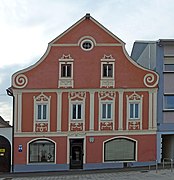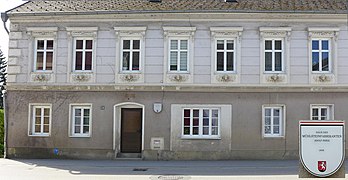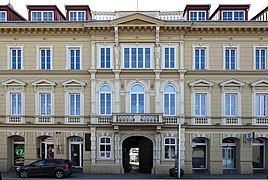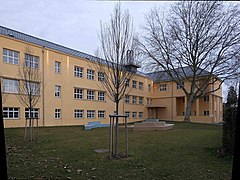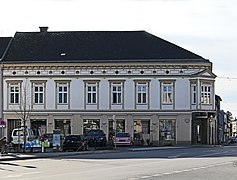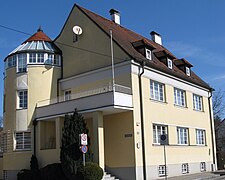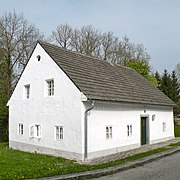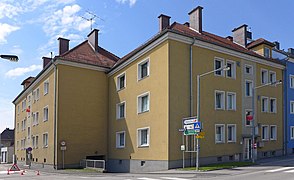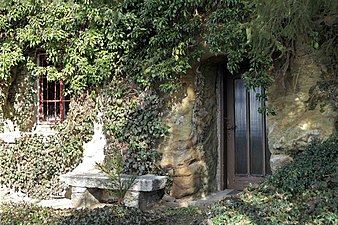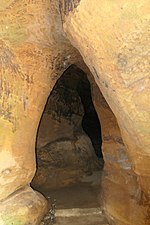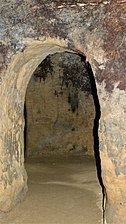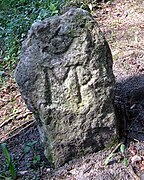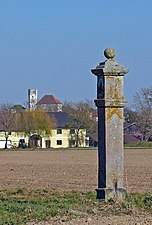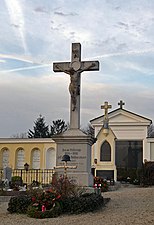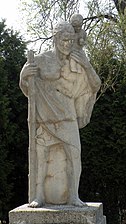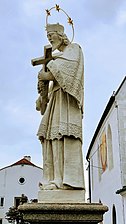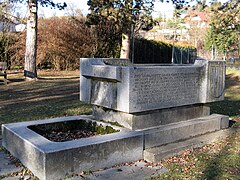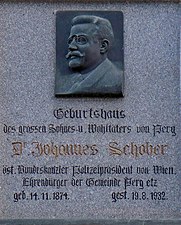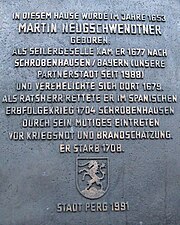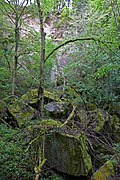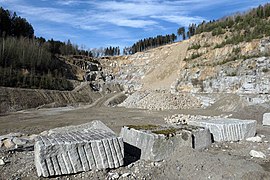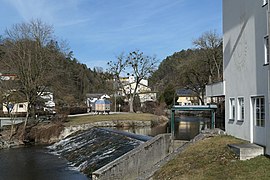Buildings in Perg
| PERG IM.M (Machland) | ||
|---|---|---|
|
Fresco painting on the Perg church tower |
||
| Geographical location | 48 ° 15 '0.8 " N , 14 ° 38' 0.8" E | |
| Height: | 250 m above sea level A. | |
|
|
||
The city and the district of Perg are located in the Mühlviertel in Upper Austria . The town has 3 cadastral communities: Perg, Pergkirchen and Weinzierl . The buildings and sights presented here give a glimpse of the Perg area, which has meanwhile developed into a center of the Lower Mühlviertel.
Castles and mansions
- Perg Castle, owned by the Lords of Perg and Machland , once stood above the houses of the market on Dollberg. It was the seat of the noble family of Perger in the 11th and 11th. 12th Century. Hardly any traces have survived from this castle. See article → Burg Perg
- The Pergkirchen castle church of the Lords of Perg and Machland is 3.2 km east of Perg. It was built in the 11th century. Romanesque wall parts of the castle have been preserved in the church and in the rectory opposite. Monument protection object ID 22869 and 22870. See article → Parish church Pergkirchen .
- The Mitterberg Castle of the Lords of Perg and Machland is located 2 km east of Perg on a spur of the terrain. Walls, parts of the curtain wall, the stump of the keep and a vaulted cellar are all surrounded by forest. Mitterberg was formerly the largest castle complex in the Mühlviertel. From 1225 to 1491 it was the seat of the major district court of Machland. No monument protection. See article → Mitterberg Castle Ruins .
- Auhof Castle is located 3 km south-east of Perg in the village of Auhof. It is mentioned for the first time in the 13th century as a noble mansion . Numerous owners. In the possession of the Baumgartenberg monastery , the castle was named Sankt Bernhardshof . The preserved parts are inhabited private property and included in the Auhof farm. Monument protection object ID 22873, 22876, 2280 and 77500. See article → Auhof Castle
- The noble seat Thurnhof is located 2 km east of Perg in the village of Thurnhof. The two-story preserved medieval residential tower is a specialty. The complex was surrounded by walls and a moat. The preserved parts are privately owned and included in the Thurnbaue r farm , Thurnhof N ° 1. No monument protection. See article → Wasserburg Thurnhof .
Churches and chapels
- The parish church of Pergkirchen was consecrated to St. Martin in 1088 . It stands on the local square and is surrounded by the cemetery . 1142 is considered to be the year in which the parish was created by separating from the old parish of Naarn . Monument protection object ID 22869. See → Article Parish Church Pergkirchen
- The Pergkirchen rectory was part of the 11th century castle church complex of the Lords of Perg and Machland. Monument protection object ID 22870. See → Article Parish Church Pergkirchen
- The parish church of Perg is a three-aisled, Gothic hall church on Perg's main square. It is dedicated to St. Jacob . In 1416, in place of a wooden church that can no longer be identified, a stone Jacob's chapel was built, which was expanded into a Jacob's church around 1500 or 1528 (the year the tower was added). She received parish rights on October 15, 1542. 1708 church fire. Last renovated in 1972/73 inside and 1987 outside. Monument protection object ID 22868. See article → Stadtpfarrkirche Perg
- The Kalvarienbergkirche Perg is a widely visible landmark of Perg. It is located just under a kilometer from the main square on a hill (about 290 m above sea level) in the north of the city and is part of the cemetery complex. Monument protection object ID 22866. See article → Perger Kalvarienbergkirche and Perger Friedhöfe
- The Perg burial chapel on Kalvarienberg contains a representation of the Holy Sepulcher . It was also called the Peregrini Chapel (after St. Peregrinus Laziosi ). From the middle of the 18th century, last of originally 5 stations of the cross. On the southern edge of the Perger cemetery complex. Monument protection object ID 22867.
- The 13 granite stations of the cross line the route from the city center to the Perger Kalvarienberg. It was donated in 1837 by the Perger citizen and coppersmith Franz Paur (he owned the house at Hauptplatz N ° 3, previously Markt N ° 10). It was the grandfather of the later Mayor of Perger, Johann Paur (1849–1932). Renovation in 1977. New picture panels made of embossed copper. The old ones, made of painted iron, were crumbling. Created by the Steyr artist Eva Biesenberger. The station of the cross I bears the inscription: ST.I - FRANZ BAUR KUPFERSCHMIED IS THE FOUNDER 1837 - I. SCHWAB. Monument protection object ID 19334.
- The village chapel Aisthofen was built between 1885 and 1890 after a village fire in the center of the village. The interior was renovated in 1987. No monument protection.
schools
For a detailed description of the schools, see the article → Perger schools
Museums
- The Heimathaus-Stadtmuseum Perg , Stifterstrasse N ° 1, includes a documentation of the history of Perg and its surroundings. The focus of the display collections is on the stone and millstone industry, which is important for Perg, the kaolin mining in Kriechbaum (Allerheiligen municipality), the finds from the Auhof burial ground (8th to 10th centuries) and the Mitterberg castle ruins. Since 2004, the permanent exhibition Kätes Puppenwelt can also be seen.
- The Mühlsteinmuseum Steinbrecherhaus , Mühlsteinstrasse N ° 43. It is part of the museum ensemble Steinbrecherhaus - Erdstall Ratgöbluckn - Mühlsteinbruch Scherer . Monument protection object ID 128648.
- The Oldy-Kai private museum by Josef Kaimüller († 2020), Gartenstraße N ° 18, includes a collection of historical radios, gramophones, tape recorders and two-wheeled nostalgia, bicycles, mopeds, motorbikes, auxiliary engines, a workshop and billboards.
Houses (selection)
Bahnhofstrasse
N ° 12 House for dentists Hans Reindl († 1959). Built in 1928. Architect Mauriz Balzarek . Originally with a flat roof on the tower. The treatment room was in the round tower room on the first floor. This resulted in ideal natural lighting conditions. In 1980 Friedrich Achleitner wrote about the house:
Balzarek's late work, in which he deals in an impressive way with volume and surface, the dynamic design of simple forms. The former villa has been preserved in its appearance despite its rededication [for a short time at that time tax office].
N ° 21 Romantic Wilhelminian style. Former home of Anton Mück . House number until 1958 Markt N ° 67.
N ° 23 Economical Art Nouveau. Former home of Karl Wögerbauer , master builder in Perg. Built in 1908/1909.
N ° 32 Capatect industrial plant. At the location of the former millstone and wooden disc stone production Fries, Burgholzer & Comp. Opposite the train station.
Friedhofstrasse
N ° 1 Simple Wilhelminian style. Children's institution, kindergarten. Architect Raimund Jeblinger . Opened in 1892. Cross sisters took over the management . A handicraft school was located in the building until 1962. There was a house chapel for the Sisters of the Cross. Renovation and expansion from 1970 to 1972 and again in 1993. The building was acquired by a bank in 2019. The monument protection was abandoned.
main square
N ° 4 Town Hall. The market chancellery was set up in 1736 in a house bought by Markt Perg . Burned down in 1839 and again in 1875. 1876 New building as a representative town hall in the Wilhelminian style (Viennese Ringstrasse style). The staircase ceiling is decorated with the local coat of arms. Monument protection object ID 1909.
N ° 21 Historic town house (commercial and residential building). Curved gable. Baroque decorations from 1782. Ground floor rebuilt insensitively. Monument protection object ID 1905.
Herrenstrasse
N ° 1 on the corner of Hauptplatz-Herrenstrasse. Historic town house. Built in 1563 and used as a soap factory from 1671 to 1879 . Baroque facade with stucco decorations and window baskets date from 1720. Sensitively modernized in 2000. Monument protection object ID 1901.
N ° 28 Hotel Waldhör. Monumental Wilhelminian style building. Built in 1870 by the brewery owner and mayor Karl Terpinitz (1824–1895). Sensitively modernized.
N ° 38 House of the millstone manufacturer Adolf Fries (1865–1913). Built in 1898. Typical town house at the turn of the century.
N ° 41 Historical craftsman's house (Weber) with a commercial building added in 1929 (greisslerei, goods store). Master builder Kager, Naarn. Modernization of the facade and ground floor. In 1980 Friedrich Achleitner wrote about the extension:
If there is not a well-known planner behind the design, one could speak of a particularly successful example of the anonymous architectural coexistence of old and new. Both facades [the historical one and the one from 1929] stand side by side, completely different in their formal elements and yet related to one another, respecting the same scale.
N ° 54 at the corner of Machlandstrasse. Early example of social housing (community housing ). Erected on the site of Dr. Schober-Landhauses Markt N ° 67.
Linzerstrasse
N ° 1 Wilhelminian style building on the corner of Hauptplatz and Linzerstrasse. Former Reichmann wholesaler, formerly with its own horse stables on Linzerstrasse, and its own weighbridge in front of the house on Hauptplatz. Sensitively modernized. Josef Manner (1865–1947) learned the profession of clerk here from his step-uncle Carl Reichmann. In 1890 Josef Manner then founded the Manner confectionery factory in Vienna .
N ° 18 school building. Master builder Wögerbauer & Simader. Opened in 1929 as a community school (Hauptschule). Architect Maurize Balzarek . A departure into the modern age in terms of the spatial plan and appearance. 1973 renovation with incomprehension about the building. Recently renovated extremely sensitive. Monument protection object ID 1103. See article → Schools in Perg
N ° 20 school building. Opened in 1893 as a primary school. Wilhelminian style building. Already had a gym. Architect Raimund Jeblinger . Recently renovated with understanding. Monument protection object ID 1102. See article → Schools in Perg
N ° 21 Modern private house. Facade with fresco.
Mühlsteinstrasse
N ° 43 Historic suburban house. Erected in 1802. With low rooms, small windows and the black kitchen (Rauchkuchel). Since 2007 Mühlsteinmuseum Steinbrecherhaus . Museum open air area. With Schaumühle Meisingermühle since 2019. Monument protection object ID 128648.
Naarnerstrasse
N ° 6 Bourgeois forge house 1590–1979 in Naarnerstrasse, formerly known as Kirchengasse (Kühgasse, Kurgasse). The southern extension that has been preserved served the blacksmith as an open, yet weather-protected work area in a convenient location.
Dr. Schoberstrasse
N ° 1 historic market judge house. Community center and inn. 1668–1910 Josef Fries brewery (so-called Stamm-Fries). Sensitively modernized.
Stifterstrasse
N ° 1 Modern commercial and residential building of the painter and house painter Josef Uhl. Converted to the Heimathaus-Stadtmuseum Perg .
Villa street
N ° 9 Villa Perghof. Loving Art Nouveau. Carefully maintained house.
N ° 11 Villa Weghofer-Karlinger. Generous Wilhelminian style. Sensitively renovated.
Underground
Sandstone cellar
Large town houses with their own farms and restaurants had separate large storage cellars. The sandstone cliffs in Perg along Lebinger and Mühlsteinstrasse and elsewhere made it possible to create cavities with little effort. So many large sandstone cellars were built along the streets. • The basement portal at Lebingerstraße N ° 13 is labeled 1616 GS. • The cellar portal at Lebingerstrasse N ° 19 (Steinbrunner homestead, Stoabrunna) is labeled JOHANN EHRNREICH HOLZMANN 1660. In 1707, Johann Holtzmann also owned the inn at Hauptplatz N ° 5. • The cellar Mühlsteinstrasse N ° 4 is part of the Mannerkeller restaurant accessible to visitors.
Cave dwellings
The sandstone rock also made it possible to build small cave dwellings. Such a cave dwelling was preserved at house Mühlsteinstrasse N ° 2 (without built-in). It used to have its own house number Obervormarkt N ° 58. Private ownership.
Earth stables
The Erdstall Ratgöbluckn, also known as the robber cave , is a system of corridors and chambers dug into the sandstone rock. In olden times it offered a place of refuge and hiding. The Erdstall is named after the former landowner Rathgeb . And Luckn stands for hole . It is located in the Stefaniehain green area . This green area was laid out in 1881 by the Perg Beautification Association. It was named after Stephanie of Belgium , the wife of Archduke Rudolf . The Erdstall is now accessible to a museum. Monument protection object ID 128648. See article → Ratgöbluckn in Perg
Other well-known earth stables are located at the Klambauer homestead (village Auhof N ° 1) and Thurnhofbauer homestead (village Thurnhof N ° 1). See article → Wasserburg Thurnhof
Monuments
Keep and boundary stones
As Burgfried that district was called, who was inside the specially marked area of the market and the city. The boundaries of the castle keep were the subject of great attention to the community. The lower jurisdiction of the market or the city ended at the castle cemetery. In Perg there are 4 castle cemetery stones. • The main castle cemetery stone MP 23 from around 1690 was preserved in the front garden of the private house Greiner Straße N ° 9. Originally this stone stood 91 m further west on Greiner Straße (the ancient Hauderer-Straße ) exactly on the Perg-Pergkirchen parish boundary. The stone was moved in the course of road widening. No monument protection.
Two preserved castle cemetery stones in the north indicate the border to the former community of Weinzierl: • The stone MP 8 stands south of the Scherer homestead in front of the Bergstraße N ° 10 area on the ancient path to Allerheiligen. • The stone MP (without number) stands next to the Hinterbach below the house at Mühlsteinstrasse N ° 43. • A fourth stone in the northeast was only discovered in 2008. The stone MP (also without a number) stands next to a transformer house opposite the Poschachersiedlung house N ° 8 on the ancient route to Altenburg and Pergkirchen . No monument protection.
In addition, a niche block pillar was preserved on the keep boundary. It stands next to the Alte Donaustraße B3c (the continuation of the old Hauderer-Straße to the west) opposite the Weinzierl-Süd N ° 60 operating area. It marked the point where the maleficent (criminal sentenced to death) had to be handed over to the Schwertberg district court . The Schwertberg execution site (gallows) was only 600 m further west on a hill (the Mühlberg) at the so-called Galgenhäusln Weinzierl-Süd N ° 15 and 16. No monument protection.
Pillory and wayside crosses
- The Perger pillory dates from 1583. It is a granite square column with some folk ornaments. The pillory was probably removed from Perger's main square in 1789. He then lay in a barn unnoticed. It was found again in 1900 and set up behind the then official building in the Fadingerstrasse area. In 1933 he came back to the main square. In 1965 it was transferred to the traffic island and supplemented with the top stone and sheet metal flag. It has now largely returned to its old shape. Monument protection object ID 1902. See article → Marktkommune Perg
- Plague column Perg. Tuscan high column with tabernacle. It dates from 1681. Originally located between the fields on the road to Wimm and Naarn (at the current level crossing). Since 1968 on the main square on the north side of the church. 1990 Renovation by Josef Primetshofer, Steyr. Monument protection object ID 1904.
- Pergkirchen plague column. Tuscan high column with tabernacle. With the year 1684. Renovated. Location north on the edge of the village of Dörfl. It reminds of the plague in Pergkirchen in 1683/84. At that time 64 people died in Pergkirchen, while the average number of other deaths was 19. Monument protection object ID 22871.
- Plague column Karlingberg-Lehenbrunn. High pillar. High degree of weathering. Location at the Windhaag-Münzbach fork in the road. A reference to the plague period 1683/84 in this area is possible. No monument protection.
- Plague column Tobra. Pillar shrine. Year 1856. Renovated in 2009. Location between the fields Tobererfeld-Klammwiesen west of the houses of Tobra. No monument protection.
- Wayside shrine French cross. Erected in 1866. Renovated in 1990. Located in the grassland next to Lininger homestead (Pergkirchen N ° 9). It commemorates the hardship suffered during the French Wars. No monument protection.
- The Hundstorfer Kreuz, a box or board cross, stands on the edge of the forest near the Hundstorfer homestead, Lanzenberg N ° 20. Renovated in 1990. It may serve as an example for other wayside crosses and chapels near homesteads. Well looked after and maintained by the residents of the homesteads.
War memorials and statues
- The Perger war memorial stands in front of the school at Linzerstrasse N ° 18. Created in 1961 by the sculptor Adolf Kloska . Granite. It shows a pietà on the pillar and the names of fallen and missing soldiers from both world wars.
- The Russian war memorial at Perg cemetery commemorates the Soviet soldiers buried there.
- The stone heroes' cross in the middle of the Perger cemetery replaced the wooden cemetery cross in 1922. It commemorates those who died in the world wars.
- The Pergkirchen war memorial on the church wall at the cemetery shows the names of fallen and missing soldiers from both world wars in the then cadastral community of Pergkirchen.
- The Christophorus statue made of artificial stone, created by Friederike Renate Stolz from Linz. Location on the Naarn at Hafnerplatz. Construction together with the Naarn Bridge there. Bridge opening in 1951.
- The Nepomuk statue dates from the middle of the 18th century. Location since 1973 on the south side of the parish church. Monument protection object ID 1089.
Fountain and heraldic animal
- Historical Karbrunnen (Koarbrun, name origin in the word Kar or Karl for vessel, bowl, basket, box). Location on the main square as a market fountain. Erected in the second half of the 17th century. Granite, octagonal. Four gargoyles. Monument protection object ID 1903.
- Historical public fountain in the lower fore market. Only the renovated well shaft has been preserved. Behind the former Lindenwirt, Naarntalstrasse N ° 1.
- Radler-Wöß fountain. Created in 1972 by Radler-Wöß. Remembering the Naarn regulations in the 18th century (years 1776–1779) and in the 20th century (years 1968–1972). Location Seyr green area (Seyr Park). See article → Perger Au .
- Steinbrenner fountain. Donation from the Perg Lions Club in 1990. Created by Theophil Steinbrenner . Location in front of the school at Linzerstrasse N ° 20.
- The unicorn as the heraldic animal of Perg. Erected in 2004 on the main square. Made from copper sheets by students from secondary school 1. Removed in 2016. New unicorn made of horseshoes . Created from 1200 horseshoes by Sascha Exenberger from St. Kathrein am Ofenegg (Styria). Replaced the sheet copper unicorn.
Memorial plaques
• Dr. Schoberstrasse N ° 2, birthplace of Federal Chancellor Dr. Johannes Schober . • Herrenstrasse N ° 26, birthplace of Martin Neugschwendtner. He saved the twin town of Schrobenhausen (Germany) from military destruction. • Herrenstrasse N ° 24, memory of Anton Bruckner and his Perger prelude. • Herrenstrasse N ° 5, birthplace of Diocesan Bishop Josef Fließer . • Rock face in the Stephaniehain, memory of the co-founder of the beautification association Perg Karl Thanheiser, innkeeper on the main square († 1902).
Quarries and hydropower
- The Scherer mill quarry in the upper Mühlsteinstrasse area is part of the Steinbrecherhaus museum ensemble. It has been accessible again as part of guided tours since 1988. Monument protection object ID 128648. - There were more millstone quarries in Zeitling-vorderes Zaubertal, Oberer Kerngraben, along the Linzerstrasse and in the Mühlsteinstrasse-Dollberg area. The Perger Stain speakers were mentioned for the first time in a document as early as 1391 . In 1582, Emperor Rudolf II confirmed the craft regulations . The millstone breaker guild existed in Perg until 1859. From 1872 the company Fries, Burgholzer & Comp continued the millstone production. After 1918 the craft millstone breakers (they called themselves millstone hewers ) gradually died out.
- Drum mountain granite quarry . Original owner Michael Burgholzer. Location on the right bank in the Naarn valley. Still in operation. Natursteinwerke Poschacher. From this quarry comes the huge number of paving stones for Vienna as well as the 8.4 m high monolithic stone of the Republic of the Memorial against War and Fascism in Vienna.
- Other Poschacher granite quarries that have now been closed were: • The Hammerleiten quarry . Original owner Georg Willnauer. Closed in 1942. Location on the left bank in the Naar valley. Use as a shooting range. • T he Lanzenberg break . Original owner Josefa Herndl. Forest site in Zeitling-Hinteres Zaubertal. • The Hörzenbergbruch . Location on the left bank ~ 0.9 km behind the Kuchlmühle. • In addition, there were various smaller, nameless granite mining sites, often hidden in the forest.
- Management of the Poschacher quarries and hammer smithy, house Naarntalstrasse N ° 23. Behind it, a newer power station. The Perger hammer with water-driven blacksmith hammers (tail hammers) used to stand here. First mentioned in 1438. Original owners of the Enengl family. Operations manager until 1954 Franz Spatzek. From 1959/1960 A. Poschacher electricity works. Turbines from Voest-Linz. Sgrafitti by Willy Hengl from 1960.
- Kuchlmühle , Kuchlmühle N ° 4, on the Naarn and already outside the Perger municipality. Already mentioned in 1449. The mill is shut down. Restaurant business expanded to Gasthof Kuchlmühle, family Hametner.
- Hausmühle , Naarnalstrasse N ° 9, from the times of the Lords of Perge in the 13th century; and • Bruckmühle , Hafnerplatz N ° 1, first mentioned in 1524. Both are on the Naarn in the city of Perger. They have been expanded into modern mills: Schälmühle Nestelberger and Dirneder-Mühle.
- Other mills in the city that have now been closed were: • Schönbeckmühle , location Naarntalstrasse 20, an oil mill from the 17th century. • Klausmühle , location Naarntalstrasse 15, first mentioned in 1550. Both mills have been completely demolished. • Hydroelectric power plant from the machine manufacturer Schöberl & Söhne (founded 1879). Location on the Naarn, Kickenau N ° 1, former Linninger oil press. Completely worn. The successor company is Bulmor-sideloader-solutions.
- Kropfmühle am Tobrabach, village Dörfl N ° 12, first mentioned in 1508. The hydropower plant has been removed. Mill building is inhabited.
- Steghammer am Tobrabach, village Dörfl N ° 7 (residential building) and N ° 13 (blacksmith building). First mentioned in 1628. Completely preserved water-powered blacksmith hammer (tail hammer) from 1880. Forge building in ruins. The headwater canal is leveled.
- Meisingermühle , moved from the Maltatal (Carinthia) to Perg, is a stone milling foam mill on the site of the Steinbrecherhaus, Mühlsteinstrasse N ° 43.
swell
- Friedrich Achleitner: Austrian architecture in the 20th century. Volume 1 with Upper Austria. Residenz-Verlag, Salzburg 1980, ISBN 3-7017-0248-9 . Page 79 with Perg and the houses Bahnhofstr. 7 and 12, Linzerstr. 18, Herrenstrasse 41, Friedhofstr. 3 and student residence Machlandstr.
- Florian and Konrad Eibensteiner: The home book of Perg, Upper Austria. Illustrated homeland book. Self-published, Perg 1933, printed by J. Wimmer, Linz, 214 pages.
- Hildegard Spreitzhofer: Perg in old views . 78 Image Documents. European Library, Zaltbommel, The Netherlands 1995, ISBN 90-288-6102-5 .
- Stadtgemeinde Perg (Ed.): Perg. Festschrift on the occasion of the city survey in 1969 . Trauner-Druck, Linz, 99 pages.
- Association for the publication of a district homeland book Perg (Hrsg.): Our home. The district of Perg . Druckerei Trauner, Linz 1995, 520 pages.
- Heimatverein Perg and Stadtgemeinde Perg (ed.): Heimatbuch der Stadt Perg 2009. Denkmayr Druck, Linz, ISBN 978-3-902598-90-5 , 555 pages.
